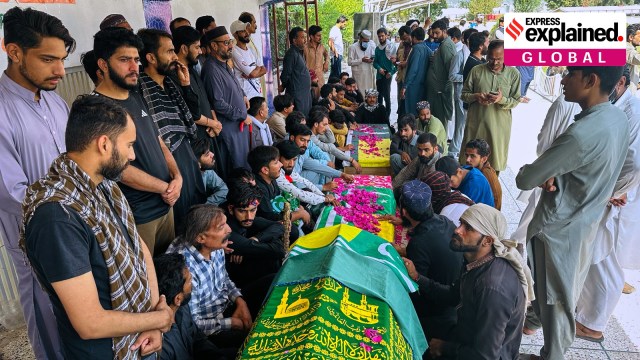Several dead in PoK unrest: The protesters’ demands, how Pakistan govt responded
PoK unrest, Pakistan-occupied Kashmir protests: While Pakistan often blames any unrest in Pakistan-occupied Kashmir on India, the current round of protests go back at least two years. We explain.
 Pakistan-occupied Kashmir protests:
People sit around the bodies of three victims, who were killed in Wednesday's clashes between police and protestors, before their funeral prayers, in Muzaffarabad, the capital of Pakistani-occupied Kashmir, Thursday, Oct. 2, 2025. (AP Photo)
Pakistan-occupied Kashmir protests:
People sit around the bodies of three victims, who were killed in Wednesday's clashes between police and protestors, before their funeral prayers, in Muzaffarabad, the capital of Pakistani-occupied Kashmir, Thursday, Oct. 2, 2025. (AP Photo)Pakistan-occupied Kashmir protests: After at least nine people, including three policemen, were killed in protests in Pakistan-occupied Jammu and Kashmir (PoK) over the past few days, a central government delegation held the first round of talks with the protesters on Thursday.
Speaking to the media after the talks, one of the delegation members, federal minister Ahsan Iqbal, urged the protesters to “avoid lighting a fire that could benefit our enemy country.”
“Our enemy country will not waste a single second in capitalising on a crisis situation in our country. And we should avoid lighting a fire through which our enemy can benefit and tarnish the image of Pakistan, cause unrest in Pakistan or the loss of life and property of the people,” Iqbal said, as quoted by Arab News.
India has condemned the action against the protesters. In a statement, the Ministry of External Affairs, as quoted by PTI, said “Pakistan must be held accountable for its horrific human rights violations” in PoK.
While Pakistan often blames any unrest in Pakistan-occupied Kashmir on India, the current round of protests go back at least two years. The protesters are led by Joint Awami Action Committee (JAAC), a civil society group of students, businessmen, and professionals. They have a list of 38 demands, ranging from the economic to the political.
From September 29, the JAAC had called for a shutdown to press for its demands. Police action on the protesters worsened matters.
How the protests in PoK began?
The current protests build on a series of demonstrations that began in 2023. Residents first mobilised against rising electricity bills and shortages of subsidised wheat. PoK residents argue that since significant hydropower is generated from the Mangla project in this region, they should not have to pay hefty electricity bills. The general economic slide in Pakistan, which affects PoK too, has worsened the sense of grievance in the area.
A major complaint of the residents has been the privileges given to government officials. At a time locals are struggling for jobs and economic security, officials get privileges like vehicles, fuel for the vehicles, and personal security staff.
In May 2024, the protests intensified. Demonstrators attempted a “long march” towards Muzaffarabad, leading to clashes in which at least five people, including a police officer, lost their lives.
Prime Minister Shehbaz Sharif subsequently announced a package of concessions, including subsidies on wheat and electricity and the creation of a judicial commission to review official privileges. Protest leaders temporarily paused their campaign but warned that failure to implement commitments could reignite unrest.
Expanded list of demands
As dissatisfaction with the government rose again, this time, the JAAC has 38 demands. A major demand is that 12 seats in the region’s legislative assembly, which are reserved for migrants from Jammu and Kashmir settled in other parts of Pakistan, be abolished. The locals claim that these seats are used by the Pakistani government to destabilise the assembly.
They also want legal cases against previous demonstrators dropped, and some royalties from hydropower projects in the region. Other points cover investment in health, education and infrastructure.
Officials in the Pakistan government said many of the demands are under consideration.
Local officials told Al Jazeera that most points had already been accepted in principle but some, such as removing reserved assembly seats, would require constitutional amendments and federal approval.
Others claimed that the reservation is meant to assure representation to those who left India and moved to Pakistan during the Partition, and abolishing it would not be fair.
What has happened in the latest round of protests?
The most recent protests, launched on September 29, have been met with a significant security response. Police and paramilitary forces have been deployed from other parts of Pakistan, schools have been closed, and communication services curtailed. Demonstrations have continued despite the restrictions, with the JAAC pressing for immediate action.
The death toll has become a source of dispute. Arab News cited government figures claiming that six police personnel were killed, while protest organisers said 12 of their supporters lost their lives. The JAAC has accused security forces of excessive force, while the government maintains it is attempting to preserve order.
The shift in the two years
Importantly, not much is known in detail about the protests to the outside world because of the curbs on internet in the area. However, the trajectory of the demonstrations seem to illustrate a shift from localised economic grievances to broader demands for structural reform.
With casualties rising and no agreement yet reached, the situation remains tense. While the federal government has signalled openness to negotiation, protest leaders want visible, concrete changes. The risk of further escalation remains, particularly if trust continues to erode between the authorities and the JAAC.
- 01
- 02
- 03
- 04
- 05






































